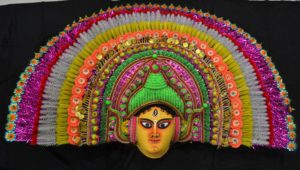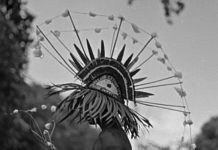Masks were considered an intrinsic part of the performing arts. Chapters on masks were included in the Sanskrit treatise on the dramatic arts, Natya Shastra (200 BCE – 200 CE). Today, masks continue to play a significant role in ritual, carnival, theatre and dance in the classical, folk and tribal traditions. Some representative uses of performance masks include personifications of goddess Durga and the Gambhira dance in West Bengal; the Krishnattam and Mudiyettu of Kerala; Sahi Yatra from Odisha,; Chham and Yak dances from Sikkim and Ladakh; Ankiya Bhaona in Assam; the Ramman in Garhwal, Aji Lhamu of Arunachal Pradesh; the Yakshagana and Boota rituals of Karnataka and the rare Islamic tradition of Pulikkettikali (tiger performances at Muharram in Kerala). The ritual dance-drama Chhau is annually performed across three eastern states on the occasion of the sun festival in the month of April. Called Purulia Chhau and Midnapur Chhau in West Bengal, Mayurbhanj Chhau in Odisha and Seraikela Chhau in Bihar, the performances are regional variants of the original theme. Featuring battles between gods and demons and morality tales, this ritual dance uses martial art and acrobatic moves.
 The main centre of Chhau mask production is in the village of Charida in West Bengal. Over a hundred households are involved. The masks are crafted in two distinct parts—the face and the headdress. Made by layering paper, cloth and clay the faces are modeled in a mould and finished with a small wood spatula (thapi). The faces of gods or goddesses, demons, heroes or animals are characterized by bold brightly painted outsized features. The outsized headdress is customised with feathers, beads, pearls, gold and silver tinsel, borders, flowers and all manner of accoutrements to form a frame around the mask.
The main centre of Chhau mask production is in the village of Charida in West Bengal. Over a hundred households are involved. The masks are crafted in two distinct parts—the face and the headdress. Made by layering paper, cloth and clay the faces are modeled in a mould and finished with a small wood spatula (thapi). The faces of gods or goddesses, demons, heroes or animals are characterized by bold brightly painted outsized features. The outsized headdress is customised with feathers, beads, pearls, gold and silver tinsel, borders, flowers and all manner of accoutrements to form a frame around the mask.
Chhau dance, its mask, costume, music and instruments, was inscribed in the UNESCO Representative list of intangible cultural heritage of humanity in 2010.




